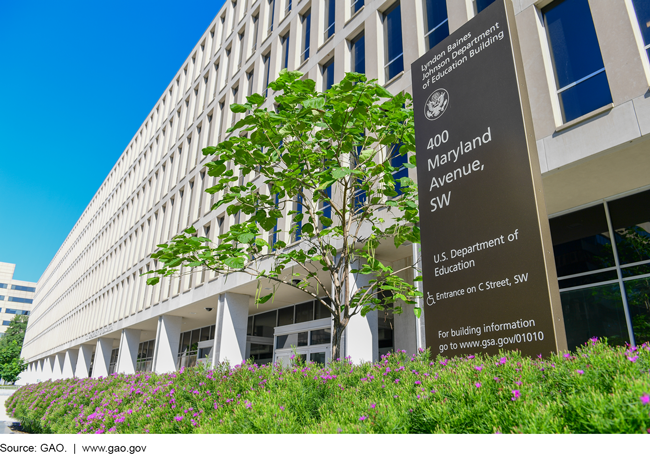K-12 Education: Federal Data and Resources on Restraint and Seclusion
Fast Facts
The Department of Education broadly defines restraint as restricting a student’s ability to move their torso, arms, legs, or head freely, and seclusion as confining a student alone in an area they may not leave. Education has said these practices should never be used except when a child’s behavior poses imminent danger.
We testified that:
Education regularly collects restraint and seclusion data from schools.
Nationally, use of restraint and seclusion is rare—but students with disabilities and boys are disproportionately affected.
Education and the Department of Justice work to address potential discrimination related to these practices.

The Department of Education building
Highlights
What GAO Found
The Department of Education (Education) collects a range of information—including incidents of restraint and seclusion of public school children—from nearly every public school and school district in the nation, as part of its biennial Civil Rights Data Collection (CRDC). Schools and districts are to use the CRDC's definitions of restraint and seclusion when counting and reporting incidents. Specifically, under Education's definitions, physical restraint broadly refers to restricting the student's ability to freely move his or her torso, arms, legs, or head. Mechanical restraint broadly refers to the use of any device or equipment to restrict a student's freedom of movement. Seclusion broadly refers to involuntarily confining a student alone in a room or area from which he or she cannot physically leave.
In March 2018, GAO reported on the use of discipline, including the prevalence of restraint and seclusion in K-12 public schools, using CRDC data for school year 2013-14, the most recent available data at the time of the work. Nationally, these data showed that the use of restraint and seclusion was very rare, but that some groups of students, in particular students with disabilities and boys, experience these actions disproportionately. For example, approximately 61,000 students were physically restrained in school year 2013-14, representing about 0.1 percent of all K-12 public school students. Mechanical restraint and seclusion were less prevalent, but again disproportionately affected the same groups of students.
Education's Office for Civil Rights and the Department of Justice's Civil Rights Division are responsible for enforcing a number of civil rights laws, which protect students from discrimination on the basis of certain characteristics. As part of their enforcement responsibilities, both agencies conduct investigations in response to complaints or reports of possible discrimination. Federal agencies have also provided guidance and resources on restraint, seclusion, and behavioral supports in recent years. For example, Education's 2012 Restraint and Seclusion Resource Document outlines principles for school districts and stakeholders to consider when developing policies to avoid the use of restraint and seclusion. In January 2019, Education announced a new initiative to address possible inappropriate use of restraint and seclusion in schools. According to Education, the Office for Civil Rights in partnership with the Office of Special Education and Rehabilitative Services will be conducting compliance reviews focused on the inappropriate restraint and seclusion of students with disabilities and will work with schools to correct noncompliance.
Why GAO Did This Study
GAO's work has shown that the use of restraint and seclusion in K-12 public schools nationwide is more prevalent among students with disabilities and boys. Education has issued guidance stating that restraint or seclusion should never be used except in situations where a child's behavior poses imminent danger of serious physical harm to self or others. In January 2019, Education released information on a new initiative focused on the inappropriate use of restraint and seclusion, particularly for students with disabilities.
This testimony discusses (1) how Education collects data on the use of restraint and seclusion, (2) what Education's data tells us about the use of restraint and seclusion in public schools, and (3) resources or initiatives at the federal level to address the use of restraint and seclusion. It is based on a report GAO issued in March 2018. This testimony also includes updated data on Education's ongoing civil rights investigations related to the restraint and seclusion of students with disabilities and Education's recent initiative on the use of these practices.
For more information, contact Jacqueline M. Nowicki at (617) 788-0580 or nowickij@gao.gov.
